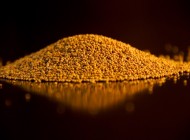I was interested to hear that most mustard is grown in Canada – I had no idea. I figured if I was ignorant to this fact there was probably a lot I didn’t know about mustard. So…I turned to Dan Brown, blogger and owner of photography business Whisky& Spice, who has most recently added the creation of custom mustards to his repertoire, to give us the dirt on mustard. Photos are of course also by Dan. We should apologize to some extent for this story since sadly, my printer did this issue far too dark and this story suffered a tad as a result…always sort of sad to see…
If you are on a browser, here is the copy, otherwise, pdf is at right:
ONE OF THE THINGS I ENJOY MOST ABOUT FOOD IS THAT IT CAN TEACH US ABOUT THE PEOPLE WHO EAT IT AND THE PLACES THAT GROW THE INGREDIENTS.
Whisky & Spice originally started as a photography blog to showcase my food and drink photography. I was working with a local butcher shop on a photography project and thought it would be fun to make and market a product to promote my photography.
I chose to make a mustard because I wanted to share something that I enjoy. I had always enjoyed mustard and mustard is a product that I knew would appeal to a broad audience. So mustard seemed to make a lot of sense.
My first step was to research and locate a source of wholesale mustard seed. Naturally, the Internet seemed to be a good place to start. It didn’t take long to learn that Canada is the world’s supplier of mustard seed. Who knew? Probably a lot of other people, but I had no idea. I was a little ashamed that I wasn’t aware of that fact but it was also exciting to learn because it meant that my product had a truly Canadian dimension to it. Knowing how popular mustard is around the world, I felt some Canadian pride knowing that our great nation is the world’s supplier of quality mustard seed.
Before the mid-1930’s most of North America’s mustard was grown in California and Montana. In 1936, 40 hectares of mustard were planted in Southern Alberta. It didn’t take long to discover that western Canada’s climate produced greater yields and better quality. Win – win. And the rest is history.
Canada grows 150,000 – 300,000 tonnes of mustard seed annually and is responsible for 75% – 80% of all worldwide mustard exports. Canada’s strict quality controls are internationally recognized and deliver consistent quality. During the 1950s and 1960s, North American mustard production expanded and concentrated into western Canada. Today, Saskatchewan and Alberta account for the vast majority of Canada’s mustard production. Three types of mustard seed are grown in Canada: white mustard seed, brown mustard seed and oriental mustard seed. Canada does not grow any GMO varieties of condiment mustard seed.
White Mustard Seed (Sinapis alba) is the mildest of all three types varieties of mustard and is used in popular yellow mustards that are synonymous with summertime backyard barbecues and ball games. Most white mustard seed is exported to the United States for use in yellow mustard condiment manufacturing but also has a variety of other applications including being used as an emulsifier, an antioxidant, a stabilizer, a preservative and a binder.
Brown Mustard Seed (Brassica juncea) offers more heat and depth of flavour than white mustard seed and is commonly used in European mustards, brown deli mustards and in South Asian cuisine. Most brown mustard seed is exported to the European market for us use in condiment mustards like world famous French Dijon mustards and German mustards. The seed has a brown or red shell with a yellow centre which gives Dijon mustard its dark yellow colour when ground into a fine powder.
Oriental Mustard Seed (Brassica juncea) is a variety of brown mustard seed but with more attitude. Asia is the primary export market for oriental mustard seed and is commonly used in extra hot Chinese mustards and English mustards. Quality oriental mustard should provide a “nasal” experience similar to wasabi paste and horseradish. Although oriental mustard seed is considered the same type as brown mustard seed it has a dark yellow colour similar to white mustard. Different varieties of oriental mustard seed are grown in Canada. Some varieties have higher oil content for pressing into mustard oil while other varieties of oriental mustard have lower oil content for grinding into powder to use as a condiment.
So there you have it. I hope that you enjoyed learning a little bit about Canada’s mustard seed industry. I know that mustard is yellow and brown but now whenever I see mustard, I can’t help but see a little red and white in there too.

